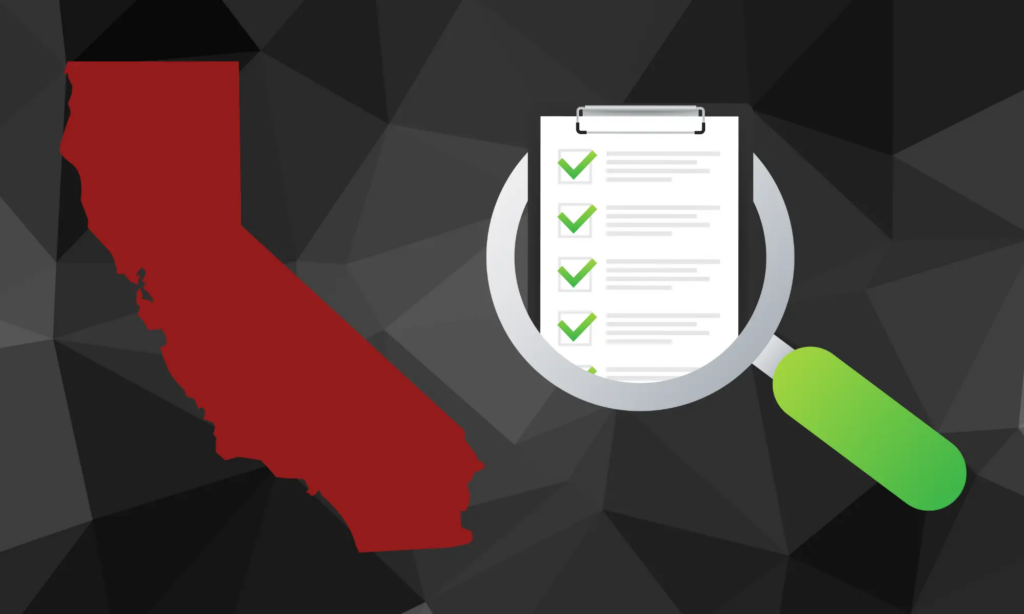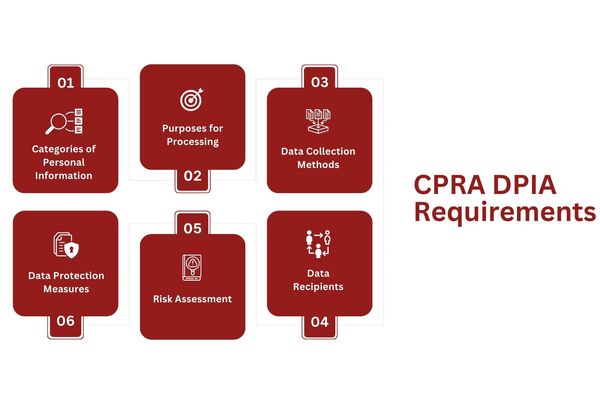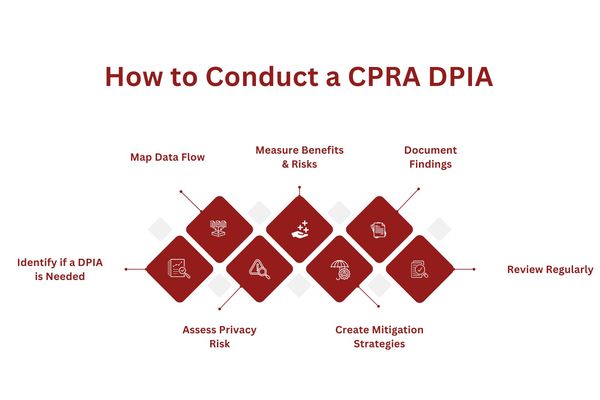
Have you ever considered the measures businesses should take to safeguard information? Allow us to introduce you to CPRA DPIA. This is a risk assessment that ensures data security as required by the California Privacy Rights Act.
This article aims to aid experienced compliance experts and newcomers in the realm of data privacy by offering insights into conducting a Data Protection Impact Assessment. This will assist businesses in navigating the evolving terrain of data protection.
Let’s dive right in.
Key Takeaways
The CPRA, also known as the California Privacy Rights Act, establishes data privacy guidelines for businesses to follow. You must take action to ensure CPRA compliance. One of these guidelines, rooted in CPRA rights, includes the requirement for businesses to carry out a DPIA.
If a business fails to conduct a DPIA when necessary, it can have consequences like penalties or undermined consumer trust.
To support businesses in understanding and complying with these regulations, Captain Compliance offers its compliance services and expertise. They assist businesses in ensuring the security of their data and building trust with their consumers.
DPIA Explained
DPIA Explained.jpg

In the realm of data privacy, a commonly used assessment is the Data Protection Impact Assessment or DPIA.
Its purpose is to assess how a business manages privacy matters, ensuring that its consumers remain protected from risks.
These assessments thoroughly analyze a business’s ability to handle and process employee data and evaluate the safeguards and security measures it has implemented. The ultimate goal is to ensure corporate compliance, an adequate level of protection for information, and relatively low risk.
Conducted under the guidance of a Data Protection Officer (DPO), DPIAs demonstrate a business commitment to upholding data privacy standards.
Why Conduct a DPIA?
Let’s explore the advantages of conducting a Data Protection Impact Assessment (DPIA) and how it can greatly assist businesses striving to safeguard data:
Risk Identification and Resolution: One advantage of conducting a Data Protection Impact Assessment (DPIA) is that it aids in the identification and management of data protection risks. By identifying these vulnerabilities, businesses can proactively address them before they escalate into concerns.
Evaluating New Data Collection Practices: Before starting any data collection method, it is advisable to conduct a DPIA. This assessment ensures compliance, with privacy regulations, allowing businesses to ensure they are handling data in a manner.
Minimizing Data Breach Risks: By conducting Data Protection Impact Assessments, businesses can greatly decrease the likelihood of security breaches, thereby protecting their reputation and earning the trust of their consumers.
Preventing Data Misuse: It is important to ensure data is not misused. Conducting DPIAs is a step in reducing the risk of misuse and ensuring that data is handled ethically and responsibly.
Enhancing Overall Data Compliance: Regularly conducting DPIAs is crucial for businesses to effectively comply with data privacy regulations. These assessments help businesses stay updated on privacy requirements and ensure compliance.
Does the CPRA Require DPIAs?
The California Privacy Rights Act, also known as CPRA, introduces regulations in California regarding data protection.
The law became effective on January 1, 2023, with CPRA bringing updates. One significant change is related to DPIAs.
Unlike the CCPA (California Consumer Privacy Act) regulation that became effective in 2018, which did not address DPIAs, the CPRA includes rules for them.
A DPIA or risk assessment is necessary when a business processes sensitive personal information. This may include the processing of data such as health records, biometric data, or financial details.
According to the CPRA, it is required for businesses that pose a risk to customer data to perform a DPIA on an annual basis.
These businesses must conduct a computer security assessment and submit a report detailing their data usage to the California Privacy Group (CPPA).
CPRA DPIA Requirements
CPRA DPIA Requirements.jpg

The California Privacy Rights Act (CPRA) has established guidelines for businesses regarding DPIAs. Now, let’s explore the components that should be incorporated in a DPIA according to these regulations:
Categories of Personal Information
The DPIA should clearly outline the different categories of personal information that will be collected, processed, or stored by the business. This can include data like names, email addresses, physical addresses, and other contact details.
It may also incorporate sensitive personal information such as biometric data, financial data, or other kinds of sensitive information.
Purposes for Processing
A DPIA should clearly explain the objectives or reasons behind processing certain types of personal information.
The CPRA requires businesses to fully articulate these intentions, which can include purposes like marketing analysis, consumer profiling, fraud prevention, and more.
Data Collection Methods
Collection methods refer to the technical ways and means of gathering personal information.
Businesses must explicitly state how they will collect data, whether directly from individuals or indirectly from other sources like cookies on their websites, mobile tracking, etc.
This disclosure provides greater transparency for consumers about where their information is collected from. For instance, If a company plans to use facial recognition software or geolocation services as part of its data collection process – this should be clearly detailed in the DPIA.
Data Recipients
This refers to individuals, organizations, or third-party service providers who may potentially receive personal data collected by the business with whom they could share this information directly or indirectly.
Businesses should mention all potential recipients of such private data in their DPIA. They should name any entities that might have access and specify how these parties will handle and protect consumer’s personal details.
Risk Assessment
Risk assessment involves identifying and evaluating the potential threats to consumer privacy associated with a business’s data processing operations.
The CPRA requires businesses to conduct comprehensive risk assessments to minimize any possible harm that could befall their consumers as a result of data breaches, accidental disclosures, or misuse.
In conducting such an analysis, likely scenarios where personal information may become compromised should be considered – not only within your organization but also by third-party recipients with access to this sensitive information.
Data Protection Measures
The CPRA emphasizes the importance of implementing robust data protection strategies to safeguard personal information. These measures could range from ensuring secure data storage environments, using encryption technologies, and maintaining stringent access controls.
These preventive actions should be documented in the DPIA and demonstrate how such defensive procedures are effective enough at countering identified risk factors while protecting an individual’s privacy rights.
How to Conduct a CPRA DPIA
How to Conduct a CPRA DPIA.jpg

The Data Protection Impact Assessment (DPIA), within the California Privacy Rights Act (CPRA), provides businesses with a roadmap on how to create a DPIA.
This guide offers step-by-step instructions for businesses to effectively craft their DPIA and ensure compliance with privacy regulations.
Identify if a DPIA is Needed
Begin by assessing whether a Data Protection Impact Assessment (DPIA) is required. If your business processes sensitive information, gathers large scales of information, or utilizes this data in unfamiliar manners (new technologies), it is strongly recommended that you to conduct a DPIA.
Map Data Flow
It is essential to have an understanding of how your data moves. This includes identifying its sources, such as forms, where it is stored on business computers, and where it ultimately ends up, which could be partner businesses or different departments.
You must identify all the data inflows and outflows of your company. This can mean collecting information from forms customers fill in on a website or hard copy documents submitted at physical locations like stores or offices.
Next, it is crucial to understand how this collected data passes through different departments before reaching its intended destination for use within the business operation framework.
Data paths may feature several stops along various units, including sales, marketing, and human resources, among others, depending upon their responsibilities tied to that specific block of info.
Assess Privacy Risk
It is crucial to recognize data problems. This involves evaluating how data is protected and if there are any potential risks surrounding privacy breaches or non-compliance with privacy regulations.
A risk assessment can help identify vulnerabilities in your current data processing activities that could lead to a breach of personal information.
Begin by conducting an inventory of your data. This includes determining the types and volumes of sensitive information that you are holding, where it is stored, who has access to this information within or outside your organization, and for what purpose.
The next step involves evaluation. Check whether there are any weak points in how you handle personal data that could potentially lead to leaking private details – be it through hacking attempts or simple careless errors made when processing the info.
Lastly, consider worst-case scenarios – these hypothetical situations should include examples such as having one’s entire database hacked into from a cyber attack, losing all backup copies due to system malfunctions, etc., then prepare strategies on how you would respond effectively under each circumstance with focus on preventing further damage quickly.
Measure Benefits & Risks
The next step is to weigh the benefits against the privacy risks of your data processing activities.
This involves evaluating how necessary and proportionate these activities are in relation to your business objectives, while considering potential threats or impacts on individuals’ rights and freedoms.
Create Mitigation Strategies
A DPIA isn’t only about identifying risks and developing necessary strategies to mitigate these identified privacy concerns. Mitigation measures could include data encryption, implementing access controls, and regular auditing procedures.
If the possible infringement on a person’s rights outweighs your company’s need for processing that information in such a manner – consider alternative methods.
Document Findings
It is crucial to keep a record of the DPIA process. This documentation needs to include the risks that were identified, the actions taken to mitigate them, and any important decisions made regarding data management.
You may use a DPIA software to carry these out or a simple spreadsheet if the amount of data is not on a large scale.
Review Regularly
A Data Protection Impact Assessment (DPIA) is not a task that you can simply complete once and forget about, it requires a consistent compliance plan. It needs to be revisited to ensure its relevance.
This means reviewing for any changes and conducting an evaluation at least once per year. Additionally, it’s important to keep the California Privacy Group informed with updates.
What Happens if You Don’t Conduct a CPRA DPIA?
Handling data comes with responsibility. The California Privacy Rights Act (CPRA) has outlined regulations regarding the handling of data by businesses. Among these regulations is the requirement for a Data Protection Impact Assessment (DPIA).
So what are the consequences if a business chooses to ignore this regulation?
Let’s consider an example involving a business called “SunnyTech.” They have recently launched an application that collects consumer data, including information such as home addresses and shopping habits.
Fueled by excitement about their venture, they jump into action without conducting a DPIA. Months down the line, disaster strikes in the form of a data breach.
The personal data of thousands of consumers becomes exposed. Due to SunnyTech’s failure to conduct a DPIA, they were not prepared for the risks. As a consequence, they now face fines under the CPRA guidelines. These fines can range from $2500 per violation to $7500 per intentional violation.
However, it’s not about penalties. Their reputation also suffers greatly. Consumer trust begins to erode as some individuals even opt to discontinue using SunnyTech services. Repairing the damage done to their brand image proves challenging.
By disregarding the CPRA guidelines, businesses not only expose themselves to repercussions but also jeopardize their relationships, with consumers and their overall reputation.
Closing
Navigating the realm of data privacy can be overwhelming for any business. Every decision and action carries weight. Understanding and implementing them can often raise questions.
So what should you do next? Perhaps you’re thinking about how to start a DPIA or seeking advice on practices for ensuring data privacy.
This is where Captain Compliance comes in. Our team is committed to providing compliance training and assisting businesses like yours in navigating these challenges.
We know every detail of the CPRA, recognize the importance of safeguarding consumer privacy, and understand the value of trust in business operations. Don’t embark on this data journey alone. Consider outsourcing compliance with our compliance solutions.
Allow us to act as your guiding compass toward a future where data protection and business growth go hand in hand. Get in touch with us today.
FAQs
What exactly is a CPRA DPIA and why should businesses care?
The CPRA requires businesses to conduct a DPIA assessment, which allows them to evaluate how they handle data and ensure its security. This assessment helps businesses adhere to regulations and builds trust with their consumers.
Thinking of implementing a DPIA for your business? Read our guide to understand what a DPIA is here!
How often should a business conduct a CPRA DPIA?
Businesses should conduct a Data Protection Impact Assessment (DPIA) on an annual basis.
Although not required by law, it is advisable for businesses to perform these assessments on a regular basis. This practice ensures that businesses stay informed, about privacy regulations and are equipped to address any risks that may arise from their data practices.
Need help setting up a regular DPIA schedule? Captain Compliance can assist. Get in touch today!
Are there penalties for not conducting a CPRA DPIA?
Certainly, if businesses neglect to conduct a Data Protection Impact Assessment (DPIA), they may be subject to penalties according to the California Privacy Rights Act (CPRA). Moreover, such businesses run the risk of damaging their reputation and eroding the trust of their consumers.
Concerned about staying compliant? Captain Compliance offers expert advice to keep you on track.